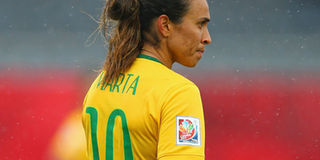Women's football: Meet the World Cup stars

Marta Vieira da Silva (Brazil). Easily the most popular and revered female footballer ever.
What you need to know:
The Women’s World Cup may not be as popular as the men’s football tournament but what it also has is a pool of talent. Now at the quarter final stage, it has shaped up nicely with the competition expanded from 16 teams to 24. But which players have stood out so far? Makhtum Muziransa profiles them.
Marta Vieira da Silva (Brazil)
Easily the most popular and revered female footballer ever. With everything she has achieved, including five consecutive World Player of the Year award (2006-2010), it’s hard to believe Marta’s still only 29.
Marta, whose physical influence on the pitch is slowly waning, still has a lot to teach the young stars, and of course, she still has unfinished business with the World Cup. In recent days, she has also waded into the FIFA crisis, suggesting that the next president of the association does not necessarily have to be a man.
Asisat Oshoala (Nigeria)
Oshoala was named the best player at the recent African Women’s Championship. She was also the best player, as well as the highest goal scorer (seven goals), at the 2014 FIFA U-20s Women’s World Cup. She is only 20, and this season signed for Liverpool Ladies. On June 8, Oshoala opened her senior FIFA Women’s World Cup account by scoring Nigeria’s second goal in a 3–3 draw with Sweden
Aya Miyama (Japan)
She is the captain of the defending champions. Miyama, 30, was a World Player of the Year finalist in January 2015, and has represented her country an impressive 151 times.
Hope Solo (United States, goalkeeper)
She is arguably the world’s best goalkeeper. Solo, 33, won the Golden Glove four years ago in Germany. The psychological edge she brings shouldn’t be underestimated, either; her presence alone inspires confidence in teammates.
Abby Wambach (United States)
Wambach, 35, is a two-time Olympic gold medallist, and 2012 FIFA World Player of the Year. Not to overlook the fact that she has scored more international goals (183) than anyone else in history. She has already scored one goal at this year’s World Cup but she missed a penalty against Colombia in the second round on Monday.
That said, we’ll know at the end whether the decision to ease her through last season, turned out to be a stroke of genius, or an indulgence too far for an icon of a passing era – after all she has announced this will be her last World Cup.
Dzsenifer Marozsan (Germany)
The Hungary-born midfielder played a major role in Frankfurt’s Champions League triumph this season. The playmaker was the youngest player to play and score in the Bundesliga, at 14 and 15 years old, respectively. She is now 23.
Christine Sinclair (Canada)
With more than 15 years and 154 goals for Canada, Sinclair is synonymous with soccer in her country. The 32-year-old forward has helped Canada fight for a spot on the world stage. She is also the third in the all-time top table of international goals scored in the women’s game.
Veronica Boquete (Spain)
The Spanish Number 10 is an artist with the ball. Spain is new to the Women’s World Cup but many Boquete is a popular player after plying her trade in Spain, USA, Sweden and now Germany.
Evolution of the Women’s World Cup
The quadrennial Fifa Women’s World Cup has evolved, since the 1991 edition hosted by China – 61 years after the men’s World Cup was held.
Uganda interfaces with the WC
In Africa, the African Women’s Championship is used to determine countries that qualify for the World Cup. Uganda participated in the Africa Cup 1998 qualifiers but lost to Egypt 1-0 at home after a one-all draw in Cairo to miss out on the continental showpiece.
For the 2003 World Cup, Uganda played Ethiopia in the Africa Cup qualifiers but again lost 4-2 on aggregate. 2-0 in Ethiopia and later a 2-2 draw in Kampala.
Meanwhile, the 2015 tournament is the first Women’s World Cup to be played on artificial turf. Artificial turf is a surface of synthetic fibres made to look like natural grass.




